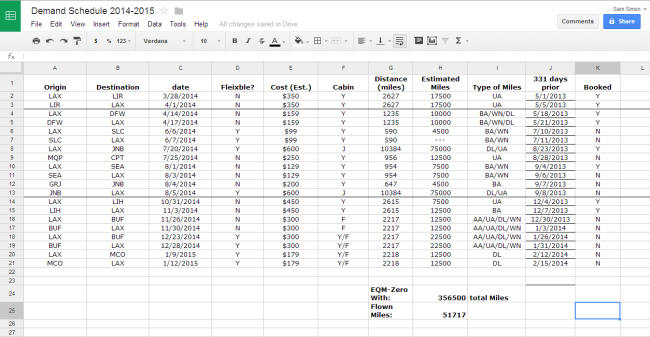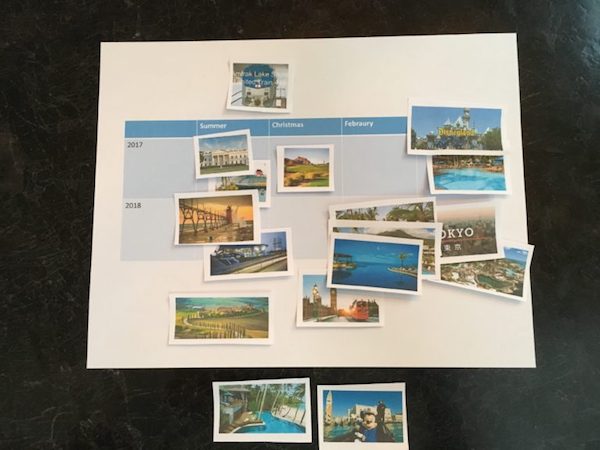Housekeeping Note: I’ve been successful in moving over email subscriptions. If you didn’t get an email about this post you’ll want to re-subscribe to the blog.
I won’t take too long to reintroduce the idea of a demand schedule. For anyone who’s new to Milenomics a Demand Schedule, as well as a Conservation system are two very important components we should all have. Both of these will be unique to you. A Mileage Conservation system splits your miles into those you’ll use for Domestic Travel and those you’ll save for larger international trips.
A Demand schedule is two things: First, it is a listing of all your possible upcoming flights. In addition to where you want to go, when you’re looking to take off and come back should be listed as well. Secondly, it is an attempt to estimate how many miles (your demand) you’ll need to earn to reach EQM-Zero, or $0 in paid flights. Using an estimate of demand helps us to stop earning miles.
“Why stop earning miles?” you might ask? There are two real reasons; because miles are depreciating while you hold them. And because you spend money, time and energy to earn them. Earning miles you won’t be using means you’ll lock your money up into those miles. Over the years maybe you’ll see them become useful, or maybe not.
Outlining your travel with a demand schedule also helps limit the number of trips you take. I’ve asked this question before on Milenomics–but if travel was free (it is not) would you consume more of it? Knowing where we want to go can help us to spend what we can afford to spend on travel, and not overspend on “free” trips.
My Demand Schedule for 2014-2015
I mentioned last week that I’m slowing down in my old age (I’m 32 now, and will be 33 soon). As such my need for Miles this year is lower than it has been ever before. I’ve got some flights booked already, and if nothing changes I’ll fly a little over 51,000 miles this year:
I’ve got my pretty regular trips like Seattle, and a SLC trip coming up. I also would love to get to see family in Orlando and Buffalo (Never again in the Winter, I’m still thawing out from Thanksgiving). For now my Demand schedule looks like this for the following 12 months:

We’re not simply listing the flights we know we will take, we should be using a demand schedule as a forecast of sorts–to gauge where we want to go in the short/long term. Dream locations, trips we’re not sure we will take, and double booking dates are all acceptable in a demand schedule.
Demand Schedules are never set in stone.
Take a look at my demand schedule. You’ll see that some of these flights are already booked. Others may not happen at all. And I’m sure I’ll be adding other flights to this list as the year goes on. Your demand schedule should be a rolling 1 or 2 year schedule of all the places you want to go even if you don’t know if you will be able to make it there.
The more complete the schedule the more you’ll be able to target your earnings. The closer your Supply of Miles and your Demand of Miles are to equilibrium the less money you’ll spend on miles you won’t use. In addition you’ll have an easier time when it comes time to book, and attempt to add on free one ways, and free round trips.
When mistake fares come up you’ll be able to capitalize by knowing when and where you want to go ahead of time. Mistake fares are often gone quick, so if you find one, and can book it for less than the cost of your miles, by all means do so. This is another good reason to put those dream trips on your schedule–a mistake fare could make a dream trip a possibility.
Put together Your Demand Schedule
There’s no time like now to start a demand schedule. If you’ve started one but let it lapse take time in the next few days to extend it out at least 1 full year from today. If you’ve already made one take today to update it, review it, and start booking whatever flights you can.
To Save miles: Use your demand schedule to try and merge as many flights as you possibly can using free one ways, the Hybrid System, or Double down bookings. If you have questions I’m avalable on Facebook, Twitter, and via Email.





Hi Sam, I got two emails – one from my signing up at the new site, and another I imagine from your migrating the addresses over. No biggie but at some point you might want to eliminate dups. Also, little typo in the title! Elaine
Elaine, Sorry about those duplicate emails. I’m working with WordPress to clean the dupes out. You might also try going to https://subscribe.wordpress.com/ and see if Milenomics shows up twice in there. Let me know if it does and if you can delete one.
Wow I must have read that title 20 times before I noticed that, *embarassed*
You were right – Milenomics did appear twice at WordPress so I just deleted the older one.
Having done quite a lot of editing in my past lives, I know that it is much easier to edit something new than something I’ve read a bunch of times. The worst are typos I’ve made in comments on blogs, where I can’t go back and fix them!
BTW, I continue to buy the prepaid cards at Safeway with no fee and no hassle. I even, albeit a bit reluctantly, bought one two days in a row, on the same card – a card I am trying to finish the minimum spend on – so I hope Citi doesn’t get suspicious. I’ve used it for the prepaid cards 4 or 5 times already but never two days in a row. I always wonder at the audacity of those who make a $5,000 or $10,000 spend in a few days with just a couple of trips to CVS…. But, so far, so good. And to me, this is better than the VRs, because there are no fees. And because we have no CVS stores 😉 .
Elaine: I’m glad that worked. I’ll still try to get WordPress to de-dupe the addresses. There are probably about 40 people getting 2 emails on new posts, so I hope they all read this comment and do the same.
Great to hear you’re still capitalizing on the PayPower Prepaids. I too continue to enjoy buying them. One tip I’ll offer: I’m a big fan of staying away from 00.00 amounts, I’ve had associates be shut down (mostly by Chase) for “round numbers.” With no fees to add the .95 at the end that means either buy groceries with the card or pick a random amount to the penny for your load.
MSers are several deviations from normal and stand out like a sore thumb. Thinking that you avoid detection by using “odd numbers” is beyond naive – it’s placing foolish hope on a patently ludicrous assumption.
CC companies tolerate most MSers – it’s just when they become abusive or present regulatory risk (ie potential money laundering/structuring etc) that you run into problems.
Once you’ve got eyeballs on your account, no amount of childish “trickery” with “odd numbers” is going to stop AA if they decide you’re a bad risk.
Every year, for probably the last 7 yrs or so, i have booked iah to ogg for the family.
Any idea why nothing being offered in the lower mileage for August? have been looking everyday for 4 months, with no luck on minimal mile offerings…usually about 20,000 each way pp, but alas, nothing like that has been showing up.
Karen,
With the United devaluation people really pushed to book seats. Hawaii is a very popular destination.
I’ll try to help: I’m assuming you need 4-5 seats. Aug 17th-19th, 5+ seats IAH-OGG 22,500 Connecting through LAX. (morning flights)
Return Can be August 25th or 26th (5+ seats both days). Both days involve a inter-island flight to HNL and then HNL-IAH nonstop. This adds an extra 6,000 miles per ticket, so the return would be 28,500 per person.
Total would be 51,000 per person. The new award chart costs 22,500 each way, so the lowest priced option would be 45,000 r/t, this is 6,000 miles higher.
Let me know if these work for you, hope this helps.
i didn’t know you had buffalo roots! nice – i like your blog even more now 😉
Yeah – demand schedules are super important for all the reasons you mention. We’ve got a big family reunion trip to Lake Tahoe in the summer and then a couple of weddings too, and then I need to figure out where we can go just the 2 of us to get away!!
Not sure how you’ll do it, but I’ll be following your blog as you go through it. That trip for 2 will be well deserved when it comes around finally. 😉
FYI only. I noticed that the information in the spreadsheet preview is different than what is downloaded.
Thanks for the comment Janet. I’m always updating my demand schedule, so as the year goes on the discrepancy between the preview and actual sheet will only get larger. You’ve got an eye for details, I only made a few small edits so far! Impressive.
How do you handle your demand schedule for multiple people? Do you have a separate one for each person or is there a way you reflect a second person in your primary demand schedule?
PP: Great question. I’m in a bit of a unique situation–my demand schedule exactly matches my wife’s (we always travel together). If I were looking to put a Demand Schedule together for more than one person I’d add two columns, one for “# of seats” and one for “Name.” A flight you’ll fly alone would be 1 seat, your name, a Flight you’ll fly with a partner would be 2 seats, both of your names, etc.
I would suggest keeping it all in one sheet–at least among those travelers you’re consistently booking flights for. An added benefit of having all flights on one sheet would be that you can book trips together whenever possible, and put together free segments and such.
More data means more flexibility in saving miles.